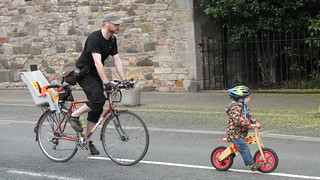To quote Dave again:
"Well, in Paris for instance, they don't get re-attached in the way you'd think (i.e. in any way at all) traffic just turns across the bike lane freely, and when one ends, you just ride on into the traffic stream."
Ignoring the assumption of what we might have thought the method of re-integration might have been, this "traffic just turns across the bike lane freely" sounds (not having experienced any specific Parisian examples) as if this might (in, for example, a country where cars routinely ignore ASLs) be no better than one of these segregated lanes we already have where cyclists can pootle merrily along away from traffic only to be returned to the road in a way where they have to stop and wait for a space before re-joining the traffic stream they were originally part of. The weird thing going round the outside of the Ocean Terminal roundabout that anth mentioned in his Ten Daftest Facilities video-set thing springs to mind. The path alongside West Granton Access keeps you out of the way of cars but then (if heading south) drops you into the middle of a junction. Even the north spur of the NEPN through the tunnel to Granton from Five Ways exits into a point between the two ends of a light-controlled section. There are the two relatively new crossings at Fountainbridge and Bowmont Place which have pictures of bicycles on the lights but which give up half-way.
Similarly only-taking-you-so-far is something like the process for heading north via MMW and thence further northwards: MMW takes you to the crossing into Forrest Road, but when the crossing shows bicycle-green, right-turning traffic from Teviot Place is also flowing and has to be yielded to. At the same crossing there's the previously-discussed but-what-if-I-wanted-to-go-along-Lauriston-Place issue.
There's the King's Stables Road contraflow cycle lane, handy for some things but which then forgets itself when it ends at a pedestrian crossing. Because cyclists can become pedestrians with a couple of simple leg-movements it sometimes seems to have been the fallback position instead of thinking properly about how cyclists' movements could be integrated into the design of a junction.
Not specifically cycle-related but similarly exhibiting the sort of thing cars do, there's the bit at the roundabout end of Holyrood Park Road (heading parkwards) where two lanes merge into one; by the markings on the road, the right-hand lane (into which cars will usually move when they see a cyclist in the left-hand-lane) is directed to merge into the left-hand-lane, but to assume that cars will do this by giving way to things in the lane they're technically merging into would be daft.
Where there's an entirely separate network above and beyond the roads-for-cars then segregation will work. It's sort of like our existing pavement/footway system, where a pedestrian can go almost anywhere without ever not being separated from live traffic either by a kerb or a stop line/red light, though it seems at the moment that pedestrians have to stop more often than vehicles. Even if it's for a reason other than narrowness of road (and I was thinking of the bit of Causewayside by Brazilian Sensation in the other thread) then points where segregated traffic is re-integrated would need some consideration to find a way of stopping the belligerence of some drivers from spoiling them.

 posts
posts
